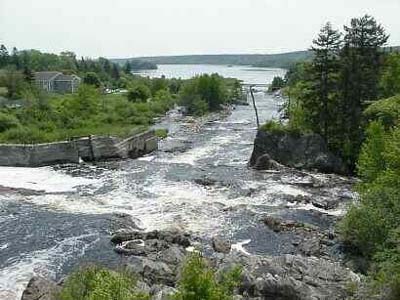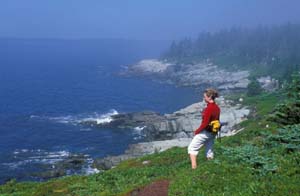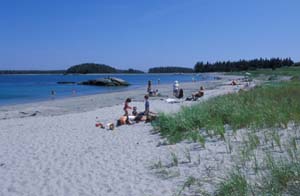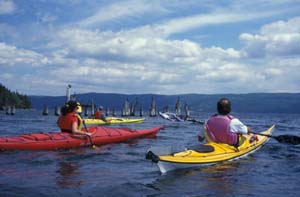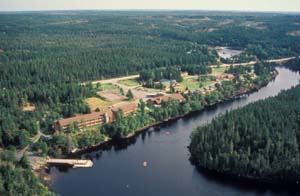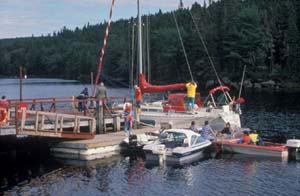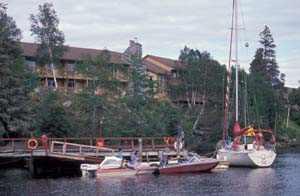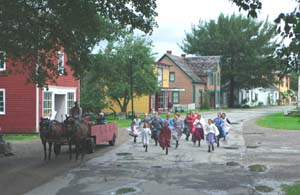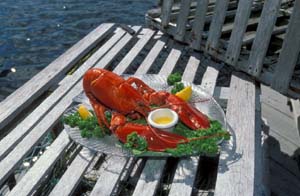Nova
Scotia's Eastern Shore: |
|||
|
|||
|
|
Nova Scotia is well known around the world for its scenic Cabot Trail, for the fertile and beautiful Annapolis Valley, and for Halifax, its engaging capital city. But few know of the treasures of Nova Scotia’s Eastern Shore, which is one of the reasons it is so special. Wide open to the tempestuous Atlantic
Ocean, the shoreline is rugged and untarnished, home to shore birds
and seals, some of Atlantic Canada’s best surfing waters, and
my favourite sandy cove nestled at the far eastern end of Clam Harbour
Beach. Known as Marine Drive in tourism terms, the trail begins just
outside of Dartmouth and follows the Number 7 highway for 155 miles
to Cape Breton. |
||
Where life is not for sale First of all, “highway” is a generous term for the quiet road that meanders through fishing villages, dipping further inland here and there, and then returning to the coast. You won’t find chain stores, fast food restaurants, four lanes, or high-speed driving. This is an opportunity to really “get away from it all” and part of that is investigating the world at a slower pace — slower, but still exciting. Lawrencetown Beach is known for its winter surfing. Not only do you have to survive the cold winter waters of the Atlantic, but also experienced surfers consider it to be comparable or better than Australia, Indonesia, California or Costa Rica. The drawing features are the long rideable point breaks, the virtually pollution-free water, and the lack of crowds. In the summer the surf is smaller and strong rip tides and currents deter all but the most confident swimmers. As one of the largest beaches in Nova Scotia, Clam Harbour Beach will either be well-populated with locals on a warm summer day, or perhaps deserted. Swimming is supervised on weekends only, but with parental supervision even the youngest swimmers are sure to have fun. Thousands visit during August when the Sand Castle-Sculpture contest is held. On the bluff above the beach is a picnic area with canteen, toilets, changing rooms, showers, and walking trails. Unknown to most of the visitors are the three private coves at the eastern end of the mile-long main beach. A trail leads over the bluffs to a stone beach cove and two sand beach inlets. Just the right size for a family day, or even a romantic couple’s picnic and swim. The best time to visit is the end of August and early September when the water has risen to almost bath temperature as the waves warm on the sand. Sea kayakers will be delighted to explore the stunning coastline near Tangier, with its numerous inlets and islands. Nature lovers will find the Eastern shore an untouched haven for forest, shore and water birds, and wildlife such as the white tail deer, rabbits, skunk, and porcupine. Along with the beaches there are inlets, marshes, and estuaries to provide a secure environment for native species. Hikers will enjoy the variety of trails at Taylor Head Park, a four-mile long peninsula that juts out into the Atlantic Ocean. Local, regional, and continental history Nova Scotia’s Eastern Shore has several unique offerings for visitors interested in history. To grasp a feeling of the local lifestyle experienced in the early 1900s, stop into the Fisherman’s Life Museum at Jeddore Oyster Pond. Set high above the rising tide you’ll find a modest wooden home where Ervin and Ethelda Myers raised 13 daughters. Typical of his neighbours, Ervin fished in the warm months, and worked in the woods in the cold ones. The family grew potatoes, carrots, and turnips, crops that would store for long seasons, and preserved berries and fish. Ethelda and her daughters made hooked rugs to decorate their floors, and colourful quilts to warm their beds. A pump organ was one of their few luxuries. Award-winning Memory Lane Heritage Village gives a taste of the life of rural Nova Scotians during the 1940s and 1950s. The village is complete from antique cub tractor to the simmering pot of baked beans and homemade bread at the cookhouse. The site includes 13 rescued or re-created buildings, including the general store stocked with original cans and boxes, a school and church, a home with a typical 1940s kitchen that contains several unidentifiable cooking instruments, a gold mine office, community garage, and the previously mentioned cookhouse – not to be missed! Another living museum is found in the town Sherbrooke and is unique in that it is an original village which is now a museum. The time period is the late 1800s to The First World War, and visitors can stroll the quiet lanes bordered by over 80 buildings (25 open to the public), and drop in to visit such businesses as the blacksmith, the general store or the sawmill. Costumed interpreters are very knowledgeable and friendly, and most visitors are pleasantly surprised by how much they enjoy their time spent in the village. One of the highlights of 2005 is the Sherbrooke Village Old Fashioned Christmas, held the last weekend of November. A very special place to stay while touring the Eastern Shore is Liscombe Lodge, known as the nature lover’s resort. There are 17 private chalets, four multi-bedroom cottages, as well as 30 riverside rooms in the main lodge. While there you may use the pool, rent canoes or paddle boats to explore the Liscombe River, or if you prefer salt water you can take a harbour tour. For land lovers there is tennis, shuffleboard, and hiking trails. Their delicious meals (planked salmon is the house specialty) are accompanied by bird song, as the forest birds enjoy their own meal outside the dining room windows. Or from the verandah you can watch kingfishers, ospreys, and eagles soar overhead and fish in the river, while you enjoy a leisurely coffee. As you can probably tell, I am partial to this area. I grew up near here and spent many summer weekends at Clam Harbour Beach. I’ve visited the villages with interesting names like Ecum Secum and Necum Teuch. I’ve explored the museums. I’ve hiked the trails and paddled the rivers. I’ve enjoyed the seafood and home cooking. If you are looking for a quiet, but fascinating, place to unwind, I’m sharing the secret with you all – come to the Eastern Shore of Nova Scotia. Other Recommended Resources Nova Scotia Adventures Companion Marine Drive Nature Tour. This detailed tour map gives directions to areas of pristine beauty with descriptions on the character and flavour of the area, and a place for your own field notes and observations. (Click on Books and Nature Guides.) |
Photographs courtesy of Nova Scotia Tourism, Culture and Heritage |
||
